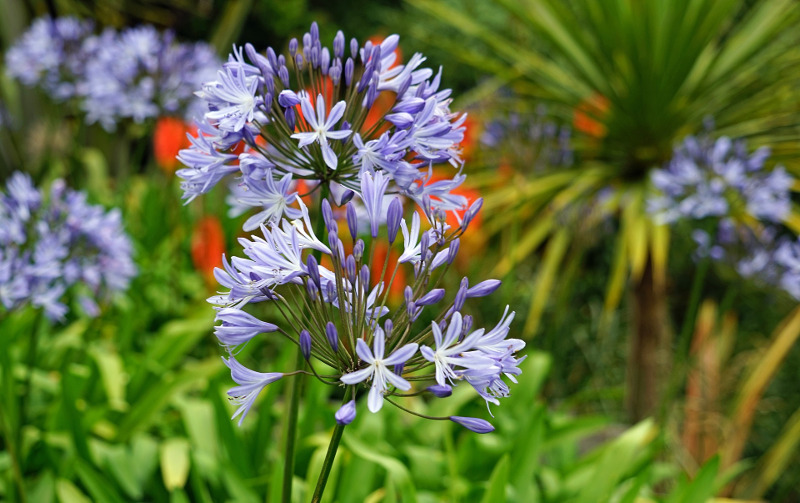Seasonal Agapanthus Treatment: Getting Ready For Winter Season and Summer season
Seasonal Agapanthus Treatment: Getting Ready For Winter Season and Summer season
Blog Article
Mastering the Art of Agapanthus Care: Essential Steps for Healthy Growth and Vivid Blossoms
In the realm of cultivation, the growing of agapanthus stands as a rewarding venture for those who seek to nurture these stylish blooming plants. With their striking flowers and elegant vegetation, agapanthus has actually recorded the focus of gardeners worldwide. Nevertheless, attaining optimal growth and lively blooms needs a nuanced technique that includes various crucial actions. From choosing the appropriate selection to understanding trimming strategies, the trip in the direction of growing prospering agapanthus plants is complex and holds the crucial to unlocking the complete possibility of these organic treasures.

Selecting the Right Agapanthus Selection

When choosing the ideal Agapanthus variety for your garden, consider elements such as climate suitability, bloom shade, and development behavior. Agapanthus, generally called Lily of the Nile or African lily, comes in a variety of shades varying from tones of blue and purple to white. Pick a blossom shade that complements your existing yard palette to create a harmonious landscape. In addition, think about the climate in your area to make sure the Agapanthus variety you select can prosper in your particular problems. Some ranges are much more forgiving of cold temperature levels, while others prefer warmer environments. Recognizing the development habit of various Agapanthus varieties is crucial for proper positioning within your garden. Some varieties have a clumping growth practice, suitable for containers or boundaries, while others have an even more spreading nature, ideal for ground cover or mass growings. By carefully evaluating these elements, you can choose the ideal Agapanthus selection to improve the beauty of your garden.
Ideal Growing Conditions
Considering the optimal ecological requirements is necessary for successful Agapanthus cultivation. Agapanthus plants are delicate to cold temperatures and ought to be shielded from frost during winter months.
To guarantee healthy growth and dynamic blossoms, plant Agapanthus light bulbs at a depth of about 2-4 inches and room them 8-12 inches apart. Including raw material, such as compost, to the dirt can improve water drainage and fertility, advertising durable origin advancement. Mulching around the base of the plants aids retain dampness and reduces weed development. Normal watering is critical, especially during the growing season, to maintain the soil regularly moist but not waterlogged.
Watering and Fertilizing Tips
Maintaining appropriate moisture levels and supplying crucial nutrients are crucial elements in the treatment regimen for Agapanthus plants. It is important to strike a balance when it comes to sprinkling Agapanthus. These plants choose consistently moist dirt yet are susceptible to root rot if overwatered. Throughout the growing period, water deeply once a week, ensuring the dirt is well-draining to avoid waterlogging. In hotter climates or throughout periods of dry spell, more constant watering might be needed to keep the soil evenly moist. Nonetheless, reduce watering in the winter months to stop water logged problems.
Feeding Agapanthus is necessary for promoting healthy and balanced growth and respected blossoms. Apply a balanced plant food, such as a 10-10-10 formula, in the very early springtime as new development arises. By following these watering and feeding suggestions, you can ensure your Agapanthus plants flourish and generate vivid, lasting blooms.
Trimming Methods for Agapanthus
Trimming Agapanthus plants at the suitable times and with correct strategies is crucial for keeping their health and advertising optimum growth and blooming. The excellent time to prune Agapanthus is in late winter season or very early spring prior to new growth arises. Beginning by removing any yellowing or dead leaves near the base of the plant. Cut them as close to the ground as feasible without damaging the emerging shoots.
For flowered stems, wait till the flowers have actually withered and afterwards trim them back to the base. This not just cleans up the plant's appearance yet also encourages the advancement of brand-new flower buds. Deadheading invested flowers can additionally reroute the plant's energy into producing more blossoms instead than establishing seeds. Nevertheless, if you desire to accumulate seeds for propagation, leave some flowers to mature and dry on the plant.
Bear in mind to utilize tidy, sharp tools to make exact cuts and reduce the risk of presenting conditions. Agapanthus. Normal trimming will certainly aid maintain your Agapanthus looking healthy and balanced and cool while ensuring a plentiful screen of stunning blossoms
Handling Typical Parasites and Diseases
After guaranteeing correct pruning techniques for Agapanthus, it is essential to address common parasites and illness that can affect the wellness and vitality of these plants. One usual bug that influences Agapanthus is the Agapanthus gall midget.
Additionally, Agapanthus plants can endure from root rot if they are grown in badly draining dirt. By being alert and taking punctual action against diseases imp source and insects, you can aid your Agapanthus plants thrive and produce vivid blooms. Agapanthus.
:strip_icc()/agapanthus-africanus-b959396b-5696f86e059c46f299d1834ba687c6eb.jpg)
Final Thought
In final thought, understanding the art of agapanthus treatment involves choosing the ideal selection, providing excellent growing conditions, correct watering and fertilizing, appropriate pruning strategies, and resolving typical parasites and conditions. By following these important actions, you can guarantee healthy and balanced growth and vibrant blooms for your agapanthus plants. Bear in mind to on a regular basis keep an eye this link on and preserve your plants to promote their overall well-being and longevity.
To make certain healthy and balanced growth and dynamic blooms, plant Agapanthus light bulbs at a depth of about 2-4 inches and room them 8-12 inches apart. By adhering to these watering and feeding ideas, you can guarantee your Agapanthus plants flourish and generate vibrant, long-lasting flowers.
One common bug that affects Agapanthus is the Agapanthus gall midge. In addition, Agapanthus plants can endure from root rot if they are grown in improperly draining pipes soil. By complying with these crucial actions, you can ensure healthy growth and vivid flowers for see this page your agapanthus plants.
Report this page